
Idaea halmaea, the two-spotted wave, is a moth of the family Geometridae. The species was first described by Edward Meyrick in 1888. It is found in Australia, including Tasmania.
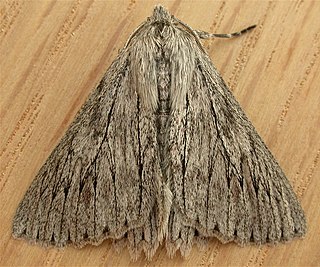
Cyneoterpna wilsoni, or Wilson's grey, is a moth of the family Geometridae first described by Rudolf Felder and Alois Friedrich Rogenhofer in 1875. It is found in the Australian states of Queensland, New South Wales, Victoria, South Australia and Tasmania.

Dithalama cosmospila is a species of moth of the family Geometridae first described by Edward Meyrick in 1888. It is found in Australia.

Aeolochroma is a genus of moths in the family Geometridae described by Prout in 1912.

Asaphodes is a genus of moths in the family Geometridae erected by Edward Meyrick in 1885. This genus is endemic to New Zealand and species within this genus are found throughout New Zealand including the North, South and Stewart / Rakiura Islands.

Chaetolopha is a genus of moths in the family Geometridae. Most species are endemic to Australia. A number of species previously assigned to this genus, were reassigned to the new genus Parachaetolopha in 2002.

Comostola is a genus of moths in the family Geometridae erected by Edward Meyrick in 1888. They are found primarily in Asia and Australia.
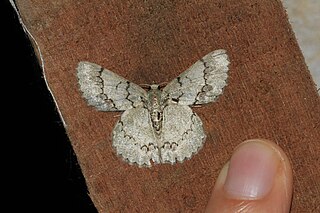
Epipristis is a genus of moths in the family Geometridae erected by Edward Meyrick in 1888.
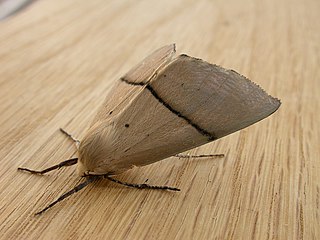
Gastrophora is a monotypic moth genus in the family Geometridae. Its only species, Gastrophora henricaria, the fallen bark looper or beautiful leaf moth, is found in the south-east corner of Australia. Both the genus and species were first described by Achille Guenée in 1857.
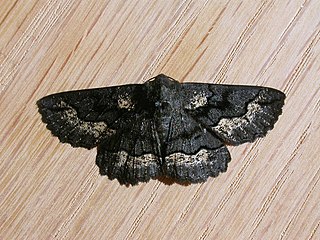
Melanodes is a monotypic moth genus in the family Geometridae. Its only species, Melanodes anthracitaria, the black geometrid, is found in Australia, more specifically in southern Queensland, New South Wales, Victoria, South Australia, and Tasmania. The genus and species were described by Achille Guenée in 1857.

Mochlotona is a monotypic moth genus in the family Geometridae. Its only species, Mochlotona phasmatias, is known from Australia. Both the genus and species were first described by Edward Meyrick in 1892.

Sterrhinae is a large subfamily of geometer moths with some 3,000 described species, with more than half belonging to the taxonomically difficult, very diverse genera, Idaea and Scopula. This subfamily was described by Edward Meyrick in 1892. They are the most diverse in the tropics with the number of species decreasing with increasing latitude and elevation.

Scopulini is a tribe of the geometer moth family (Geometridae), with about 900 species in seven genera. The tribe was described by Philogène Auguste Joseph Duponchel in 1845.
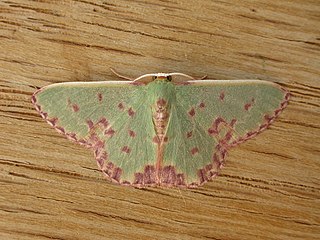
Prasinocyma rhodocosma, the northern emerald, is a species of moth of the family Geometridae first described by Edward Meyrick in 1888. It is found in Australia in northern Western Australia, the Northern Territory, Queensland and New South Wales.
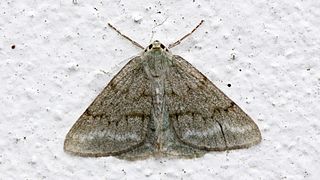
The Pseudoterpnini are a tribe of geometer moths in the subfamily Geometrinae. The tribe was described by Warren in 1893. It was alternatively treated as subtribe Pseudoterpniti by Jeremy Daniel Holloway in 1996.
Aeolochroma acanthina is a moth of the family Geometridae first described by Edward Meyrick in 1888. It is found in Australia.

Ogmograptis, the scribbly gum moth, is a genus in the family Bucculatricidae and was first described by Edward Meyrick in 1935, as a monotypic genus. They are found in the Australian Capital Territory, New South Wales and Queensland. However, in 2007, Cooke and Edwards argued that the patterning of the scribbles was different for each of the three eucalypts, Eucalyptus pauciflora, E. racemosa ssp. rossii, and E. delegatensis) and that it was likely that these differing patterns were caused by larvae from different species of scribbly gum moths.

Asaphodes chlamydota is a moth in the family Geometridae. It is endemic to New Zealand, and can be found in the lower part of the North Island and in the South Island. It inhabits native forest and shrublands. The larvae of this species feeds on native Clematis plants including Clematis afoliata. Adults are on the wing from November to April and are regarded as having intermedia flight powers.

Notoreas chrysopeda is a species of moth in the family Geometridae. This species is endemic to New Zealand. It is a colourful day flying moth that lives in mountainous habitat.
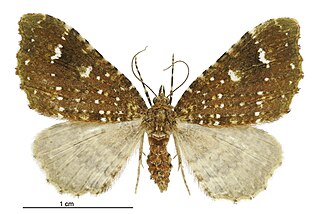
Asaphodes limonodes is a species of moth in the family Geometridae. It is endemic to New Zealand and is found in both the North and South Islands. This species inhabits damp native forest. Adults are on the wing from November until March.



















